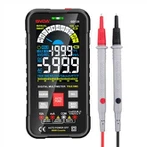Thermal Ball Anemometer Working Principle
A thermal ball anemometer consists of two parts: a thermal ball sensor and a measuring instrument. The head of the sensor has a tiny glass ball with a nickel-chrome wire coil of heated glass and two thermocouples in series burned inside the ball. The cold end of the thermocouple is connected to a phosphorus copper pillar, directly exposed to the airflow, when a certain size of the current through the specialised coil, the temperature of the glass ball rises, the degree of elevation and the speed of the airflow is related to the flow rate of the small degree of elevation of the degree of large, and vice versa, the degree of elevation of the small. The magnitude of the increase is indicated on the meter by the potential generated by the thermocouple. Therefore, after calibration, the meter can be read to indicate the velocity of the airflow.
Thermal ball anemometer is a portable, intelligent low wind speed measurement instrument, in the measurement of pipeline environment and heating, air-conditioning and refrigeration, environmental protection, energy-saving monitoring, meteorology, agriculture, refrigeration, drying, labour hygiene surveys, clean workshop, chemical fibre textile, a variety of wind speed experiments have a wide range of uses.
Wind speed test has the average wind speed test and turbulence component (wind turbulence 1 ~ 150KHz, and changes in different) test. The methods for testing the average wind speed include thermal, ultrasonic, impeller, and skin and tube.
0 to 100m / s flow velocity measurement range can be divided into three zones: low speed: 0 to 5m / s; medium speed: 5 to 40m / s; high speed: 40 to 100m / s. Anemometer's thermal probe for 0 to 5m / s ** measurements; anemometer's rotary probe to measure the flow velocity of 5 to 40m / s is ideal; and the use of the Pitot tube can be in the high speed range to get good results. An additional criterion for the correct selection of an anemometer's flow velocity probe is the temperature, typically the thermal sensor of an anemometer can be used at temperatures up to about +-7˚C, the rotating wheel probe of a special anemometer can be used up to 35˚C, and the Pitot tube can be used above +35˚C.
Thermal ball anemometers are instruments capable of measuring low wind speeds over a range of 0.05 to 10 m/s. Thermal ball anemometers consist of two parts: a thermal ball stem probe and a measuring instrument. Probe has a diameter of 0.6mm glass ball, ball wound with heating glass ball with nickel-chromium wire ring and two series-connected thermocouples. The cold end of the thermocouples is connected to a phosphor bronze strut that is directly exposed to the airflow. When a current of a certain size is passed through the heating coil, the temperature of the glass sphere rises. The degree of increase is related to the wind speed, the wind speed is small, the degree of increase is large; on the contrary, the degree of increase is small. The magnitude of the increase is indicated by the thermocouple on the meter. According to the meter reading, check the calibration curve, you can find out the wind speed (m / s).






